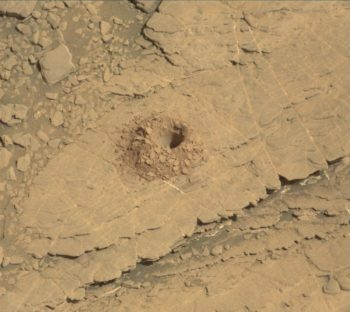NASA’s Curiosity Mars rover is now performing Sol 2488 duties and there’s now official word on Curiosity Mars rover’s recent success.
Source: Lenard David.com
On Sunday morning the team received the message that Curiosity’s latest drill hole was successful at “Glen Etive.” This is the 22nd full-depth drill hole on Mars, and we can celebrate its success on this final day of Earth-year 7 of the mission,” reports Roger Wiens, a geochemist at Los Alamos National Laboratory in New Mexico.
Clay unit: 3rd hole
Wiens adds that “Glen Etive” is the third hole in the clay unit. The other two holes, “Kilmarie” and “Aberladie,” were drilled near each other in April at a lower stratigraphic position.
This hole was achieved with no percussion, Wiens adds, and its depth is greater than 4 centimeters.

Credit: NASA/JPL-Caltech
Tailings from the drill hole will be used for analyses of this outcrop by the robot’s Sample Analysis at Mars (SAM) Instrument Suite and its Chemistry & Mineralogy X-Ray Diffraction/X-Ray Fluorescence Instrument (CheMin), as well as the Mars Hand Lens Imager (MAHLI).
Hole-Mars observations
Wiens reports that Curiosity’s ChemCam will attempt to shoot down into the drill hole to analyze the rock layers on the wall of the hole. The drill hole is the size of a dime, he notes.
“These are fresh rock surfaces and should generally represent the same material that SAM and CheMin analyze. It is dark in the hole, so the autofocus feature of ChemCam is significantly challenged,” Wiens adds. “Getting a good image down the hole requires overexposing the other parts of the image so we can see better in the dark part of the hole.”

Credit: NASA/JPL-Caltech
Sample material
The robot’s arm will be busy with drill portion characterization. The activity creates “test portions” in order to make sure that there is sample material in the drill and that the portions are of the expected amount (for instrument safety), Wiens points out.
“One is delivered to the ground and two to the back of the closed SAM inlet cover. The latter is the best ‘rehearsal’ for dropping portions to the instruments, since it also allows us to gauge the amount of deflection by wind at the height of the rover deck. Mastcam images are used for documentation in all cases,” Wiens adds.

Slip check
Lastly, the robot’s Mastcam is slated to also take a mosaic of the area around the drill hole, and ChemCam will shoot one additional nearby target, “Argyll.” The Hazcams will take images for a slip check of the rover.
Wiens concludes by noting that the robot’s Navcam will do a dust-devil movie and a horizon movie to look for clouds. Curiosity’s Radiation Assessment Detector (RAD), the Rover Environmental Monitoring Station (REMS), and the Dynamic Albedo of Neutrons (DAN) onboard the rover will also take data.

































Leave a Comment
You must be logged in to post a comment.